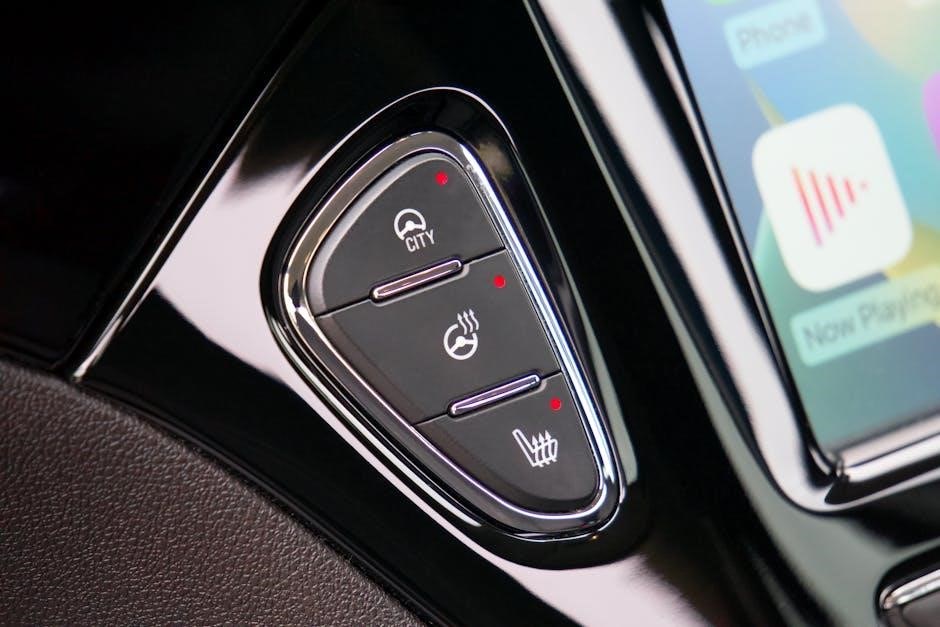Manually moving an electric car seat is sometimes necessary when power functions fail. While it poses risks like motor damage, using methods like override levers or winder tools can help adjust positions safely and effectively, ensuring proper alignment without causing further issues to the mechanism or track system always.
Understanding the Basics of Electric Car Seats
Electric car seats are powered by motors and typically controlled via switches or buttons. They move along tracks, adjusting position, tilt, and lumbar support. Key components include the motor, tracks, and control mechanisms. Manual adjustment may involve tools like a winder or override lever. Understanding these basics is crucial for safe and effective manual operation, ensuring you know how to bypass or engage components without causing damage. This knowledge helps in troubleshooting common issues like stuck seats or motor failure.
Why Manual Adjustment Might Be Necessary
Manual adjustment of an electric car seat may be needed due to power failure, faulty motors, or stuck mechanisms. If the seat’s electric system malfunctions, manual intervention becomes essential; This is particularly true when the seat is stuck in a position, refusing to move via controls. In such cases, using tools like a winder or override lever can provide a temporary solution. Understanding when manual adjustment is necessary helps prevent further damage and ensures proper functionality, even in non-operational electric modes.

Risks and Precautions
Manually moving an electric car seat risks damaging the motor or tracks. Always disconnect the battery and consult the owner’s manual to avoid mechanical harm or further issues.
Potential Damage to Seat Motors or Tracks
Manually moving an electric car seat can cause damage to the motor or tracks. Forcing the seat beyond its range may strip gears or bend metal components. Using tools like screwdrivers or drills improperly can also harm the mechanism. Even with a winder tool, excessive force may lead to irreversible damage, requiring costly repairs or replacement parts. Always proceed with caution and avoid applying too much pressure to prevent such issues.
Importance of Consulting the Owner’s Manual
Consulting the owner’s manual is crucial before manually moving an electric car seat. It provides model-specific instructions and safety precautions to avoid damage. The manual outlines the correct tools and techniques for manual adjustment, ensuring you understand the risks involved. Ignoring this step may lead to improper methods, potentially harming the seat’s motor or track system. Always refer to the manual to align with your vehicle’s unique mechanisms and prevent unnecessary repairs or complications during the process.
Manual Override Method
Locate the manual override lever under the seat to adjust its position. Use the lever to move the seat forward or backward gently, ensuring proper alignment and control.
Locating the Manual Override Lever or Handle
To manually move an electric car seat, first locate the manual override lever or handle. This is typically found underneath the seat, near the motor or track system. It may appear as a small recessed gear or a visible handle. Some models require removing a plastic plate or screws to access the override mechanism. Once located, use the lever or a tool like a screwdriver or Allen key to engage the manual adjustment feature. Always refer to your car’s manual for specific instructions.
Using the Lever to Adjust the Seat Position
Once the manual override lever is located, use it to adjust the seat position. Turn the lever clockwise to move the seat backward or counterclockwise to shift it forward. Apply gentle pressure to ensure smooth movement. If the lever is recessed, insert a screwdriver or Allen key into the recess and turn it accordingly. Be cautious not to apply excessive force, as this could damage the mechanism. Move the seat slowly and carefully to avoid sudden stops or jerks.
Techniques for Loosening a Stuck Seat
If the seat is stuck, gently wiggle the manual override lever while applying light pressure. Use a rubber mallet to tap the seat rails or base to loosen it without causing damage. Avoid using excessive force, as this could harm the mechanism. Apply penetrating oil to the tracks if rust or corrosion is present. Slow, consistent movement is key to safely freeing the seat and ensuring proper alignment once it is unstuck.
Using a Winder Tool
A winder tool connects to the seat motor, typically located on the side or back of the seat. Turning it adjusts the seat position forward or backward.
Connecting the Winder to the Seat Motor
To connect the winder, locate the motor on the seat’s side or back. Align the winder’s end with the motor’s recessed square drive. Gently insert and ensure it fits securely. This connection allows manual control, bypassing the electric system. Always follow proper alignment to avoid damage. Once connected, the winder can be turned to move the seat forward or backward as needed, providing mechanical control when power adjustment fails or is unavailable.
Operating the Winder for Forward and Backward Movement
Once connected, turn the winder handle clockwise to move the seat backward or counterclockwise for forward movement. Ensure slow, steady turns to maintain control. If unsure about direction, test a partial turn and observe the seat’s movement. Avoid excessive force to prevent damage. Proper alignment and gentle operation ensure smooth adjustment without harming the motor or tracks, making manual control effective when power systems fail or are unavailable;

Preparing for Manual Adjustment
Disconnect the car battery to ensure safety. Familiarize yourself with the seat controls and mechanisms. Locate the manual override or winder tool connection point for smooth adjustment.
Disconnecting the Car Battery
To ensure safety, disconnect the negative terminal of the car battery first. This prevents any accidental power surges or electrical shocks while working on the seat mechanism. Locate the battery, typically in the engine compartment, and use an appropriate wrench to loosen the bolt on the negative terminal clamp. Once loose, pull the clamp off the terminal. Always follow proper safety procedures to avoid injury or damage to the vehicle’s electrical system.
Familiarizing Yourself with Seat Controls
Before manually adjusting an electric car seat, familiarize yourself with its controls. Understand the location and function of switches, buttons, or levers that operate the seat. Modern vehicles often have electronic controls on the door panel or side of the seat. Knowing these will help you identify how the seat moves and where adjustments can be made. Some seats may also have a manual release or override gear located underneath. Always consult the owner’s manual for specific guidance tailored to your vehicle’s make and model.

Tools Needed for Manual Adjustment
Essential tools include screwdrivers, Allen keys, and wrenches for removing screws and bolts. A drill may be needed for stubborn parts, while bolt cutters can cut seat springs.
Screwdrivers and Allen Keys
Screwdrivers and Allen keys are essential tools for manually adjusting an electric car seat. Flathead and Phillips screwdrivers help remove screws securing the seat. Allen keys, or hex keys, are used for bolts in the seat’s adjustment mechanism. Having multiple sizes ensures compatibility with different fasteners. These tools allow access to internal components, enabling manual adjustment without damaging the seat’s motor or tracks. Always use the correct size to avoid stripping screws or bolts.
Drills and Bolt Cutters
Drills and bolt cutters are specialized tools for more challenging manual adjustments. A power drill can loosen stubborn screws or bolts that resist removal with screwdrivers. Bolt cutters are used to cut spring meshes or cables under the seat without damaging the seat itself. Be cautious to avoid cutting essential components. These tools are particularly useful when the seat is stuck or inaccessible through standard methods, ensuring safe and effective adjustments without further complicating the issue at hand.
Common Issues and Solutions
Common issues include stuck or frozen seats and weak motor sounds. Solutions involve using winder tools for temporary fixes or drills to loosen stubborn screws safely and effectively.
Dealing with a Stuck or Frozen Seat
If your electric car seat is stuck or frozen, start by gently wiggling the seat back and forth while applying light force. Use a rubber mallet to tap the seat rails if necessary. Avoid excessive force to prevent damage. Disconnect the car battery to ensure the motor doesn’t activate accidentally. For stubborn seats, a winder tool can be connected to the motor to manually adjust the position without causing further damage. Always proceed cautiously to avoid harming the seat’s mechanical components or tracks.
Addressing Weak or Unusual Motor Sounds
If your electric car seat’s motor emits weak or unusual sounds, it may indicate worn or damaged components. Stop using the seat immediately to prevent further damage. Consult the owner’s manual for troubleshooting steps or reset procedures. If the issue persists, a professional mechanic should inspect and replace faulty parts like motors or wiring. Temporary fixes, such as using a winder tool, may help, but proper repair is essential to restore full functionality and safety.

Additional Resources and Tips
For further guidance, watch recommended videos or consult professional mechanics. These resources provide step-by-step instructions and expert advice, ensuring safe and effective manual seat adjustments every time.
Recommended Videos and Guides
Several online resources offer detailed tutorials on manually moving electric car seats. Videos like “How To Manually Move a Power / Electric Car Seat” by Vehicle Freak provide step-by-step guidance. Additionally, guides from reputable sources like 1A Auto share expert tips on diagnosing and fixing stuck seats. These resources cover troubleshooting, tool usage, and safety precautions, making them invaluable for anyone attempting manual adjustments. They often include real-world examples and solutions for common issues, ensuring a well-informed approach to seat adjustment.
Professional Mechanic Consultation
Consulting a professional mechanic is highly recommended if you’re unsure about manually moving an electric car seat. They can assess the situation, diagnose issues, and perform adjustments safely. Mechanics have the expertise and tools to handle complex problems like faulty motors or wiring without causing further damage. Their intervention ensures proper functionality and prevents potential risks associated with improper manual adjustments. Seeking professional help is the best option for long-term solutions and maintaining your car’s interior integrity effectively.
Manually moving an electric car seat requires careful preparation and caution to avoid damage. Always prioritize safety, consider professional consultation, and follow proper techniques for effective adjustments without risks to ensure optimal functionality and longevity of your car’s seating system.
Final Tips for Safe and Effective Manual Adjustment
Always disconnect the car battery before starting to avoid electrical issues. Use tools like screwdrivers or Allen keys gently to prevent damage. If the seat is stuck, gently tap the rails with a rubber mallet. Avoid excessive force to prevent motor or track damage. Consider consulting a professional if unsure. Familiarize yourself with the seat controls beforehand for better understanding. Watch instructional videos for guidance, and prioritize safety throughout the process to ensure effective and damage-free adjustment.

